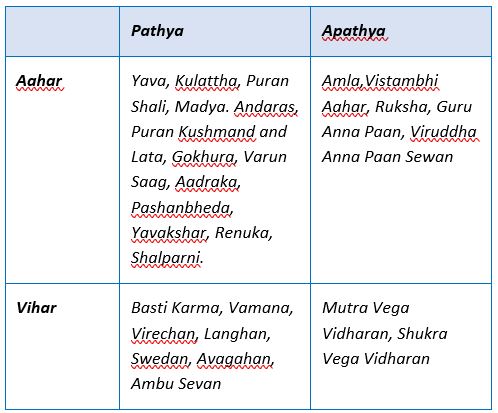An etiopathological study of Mootra-Ashmari with special reference to Urolithiasis: A Literary Review
DOI:
https://doi.org/10.21760/jaims.9.6.28Keywords:
Mootra-Ashmari, Urolithiasis, Renal CalculiAbstract
Mootra-Ashmari is a disease of urinary tract which causes problems in many ways including passage of urine. The waste material when not dissolve completely in urine and obstruct urinary path then Mootra-Ashmari may occur which is termed as renal calculi/urolithiasis/nephrolithiasis in modern medical sciences. As per Sushruta Samhita, Ashmari is included in Ashtamahagada due to its fatal nature. Description of Ashmari is found in almost all Samhitas of Ayurveda for e.g. either as a type of Mootraghata (Acharya Charaka) or as a separate disease (Acharya Sushruta). Ashmari is one of the most common disorders of Mootravaha Srotasa. It is Kaphapradhana Tridoshaja Vyadhi. Pathya-Apathya is an important factor in Mootra-Ashmari. Urinary stones frequently occur worldwide. Prevalence rate of 1-5% are reported in Asia, 12% in India. it is very much important to prevent occurrence of the disease because of the dreadful complications caused by Mootra-Ashmari and its high chances of recurrence.
Downloads
References
Shabdakalpadruma
Sastri Hara Govinda, Amarakosha, Chaukhambha publication 2006, page no 284
Shastri AD, Sushruta Samhita, Vol 1, Sutra Sthana 33/4, Varanasi, Chaukhamba Sanskrit Sansthan
Shastri AD, Sushruta Samhita, Vol 1, Nidana Sthana 3/3,4, Varanasi, Chaukhamba Sanskrit Sansthan
Shastri AD, Sushruta Samhita, Vol 1, Nidana Sthana 3/7-17, Varanasi, Chaukhamba Sanskrit Sansthan
Charaka Samhita Chikitsa Sthana 26/32, Vd Brahmanand Tripathi, Chaukhamba prakashan
Charaka Samhitaa Chikitsaa Sthana 26/36, Vd Brahmanand Tripathi, Chaukhamba prakashan
Ashtanga Samgraha Nidana Sthana 9/9
Upadhyaya YN, Madhav Nidana 1, Varanasi; Chaukhambha Prakashan; 2012. p. 639
Upadhyaya YN, Madhav Nidana 1, Varanasi; Chaukhambha Prakashan; 2012. p. 645
Murthy. K.R. Srikantha, Vagbhatas Astanga Hrdayam, vol 2, Nidana Stana 9/6-7, Chaukhambha Krishnadas Academy Reprinted 2014, page no 85.
Srikamtamurhy K.R., Vagbhata’s Ashtanga Hridaya Samhita with English translation Vol-II, Nidana Sthana 9/9-10, Chaukhamba Sanskrit Sansthan, Varanasi
Bhaisajya Ratnavali siddhiprada hindi byakhya by prof. Siddhinandan mishr,2021 edition/chaptr36/Ashmari Rogadhikar/69,70 71, page number-695
SRB’s manual of surgery, published by Sriram Bhat M., 5th edition, page no. 1015-1016
A concise textbook of surgery, Published by Dr. S Das, 5th edition, page no. 1189, 1190















